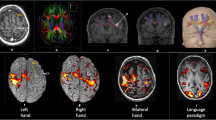Summary
Transient mutism has been known as a common manifestation following callosotomy for medically intractable epilepsy, but its cause has not been clearly elucidated. In this paper, we report three cases of mutism following a transcallosal approach to tumours in the lateral and third ventricles and retrospectively analyze the surgical, neurological and radiological features which may suggest the cause of this type of mutism.
Mutism may be a result of division of the corpus callosum. Suppression of the limbic system caused by lesions in the anterior cingulate gyrus, septum pellucidum, and fornix may have been of importance in at least two of these three cases. Impairments of the supplementary motor cortex, thalamus and basal ganglia may also be factors reducing speech production. The mechanism of such transient mutism seems to be a complex of two or more of these factors, and their combinations may be different from one case to the other.
Similar content being viewed by others
References
Alexander MP, LoVerme SR Jr (1980) Aphasia after left hemispheric intracerebral haemorrhage. Neurology 30: 1193–1202
Altshuler LL, Cummings JL, Mills MJ (1986) Mutism: review, differential diagnosis, and report of 22 cases. Amer J Psychiatry 143: 1409–1414
Apuzzo MLJ, Chikovani OK, Gott PS,et al (1982) Transcallosal, interfornicial approaches for lesions affecting the third ventricle: surgical considerations and consequences. Neurosurgery 10: 547–554
Bogen JE (1985) Split-brain syndromes. In: Frederiks JAM (ed) Handbook of clinical neurology, vol I. Elsevier, Amsterdam, pp 99–106
Bogen JE (1987) Physiological consequences of complete or partial commissural section. In: Apuzzo MLJ (ed) Surgery of the third ventricle. Williams &Wilkins, Baltimore London Los Angeles Sydney, pp 175–194
Benson DF (1979) Aphasia, alexia, and agraphia. Churchill Livingstone, New York Edinburgh London, pp 163–164
Brust JCM, Plank C, Burke A,et al (1982) Language disorder in a right-hander after occlusion of the right anterior cerebral artery. Neurology 32: 492–497
Cummings JL, Benson DF, Houlihan JP,et al (1983) Mutism: loss of neocortical and limbic vocalization. J Nerv Ment Dis 171: 255–259
David AS, Bone I (1984) Mutism following left hemisphere infarction. J Neurol Neurosurg Psychiatry 47: 1342–1344
Diamond SJ, Scammell RE, Brouwers EYM,et al (1977) Functions of the centre section (trunk) of the corpus callosum in man. Brain 100: 543–562
Ferrante L, Mastronardi L, Acqui M,et al (1990) Mutism after posterior fossa surgery in children. J Neurosurg 72: 959–963
Ferrara VL (1985) Acute traumatic mutism. Surg Neurol 23: 573–574
Geuna E, Regalia F, Pappada G,et al (1981) Septum pellucidum oligodendroglioma. Case report and review of literature. J Neurosurg Sci 25: 49–53
Gordon HW, Bogen JE, Sperry RW (1971) Absence of deconnexion syndrome in two patients with partial section of the neocommissures. Brain 94: 327–336
Jeeves MA, Simpson DA, Geffen G (1979) Functional consequences of the transcallosal removal of intraventricular tumours. J Neurol Neurosurg Psychiatry 42: 134–142
Liepmann H, Maas O (1907) Fall von linksseitiger Agraphie und Apraxie bei rechtsseitiger Lähmung. J Psychol Neurol 10: 214–227
Oepen G, Schulz-Weiling R, Zimmermann P,et al (1985) Longterm effects of partial callosal lesions. Preliminary report. Acta Neurochir (Wien) 77: 22–28
Rayport M, Ferguson SM, Corrie WS (1984) Mutism after corpus callosum section for intractable seizure control. Epilepsia 25: 665
Rekate HL, Grubb RL, Aram DM,et al (1985) Muteness of cerebellar origin. Arch Neurol 42: 697–698
Ross MK, Reeves AG, Roberts DW (1984) Postcommissurotomy mutism. Ann Neurol 16: 114
Sass KJ, Novelly RA, Spencer DD,et al (1990) Postcallosotomy language impairments in patients with crossed cerebral dominance. J Neurosurg 72: 85–90
Shucart WA, Stein BM (1978) Transcallosal approach to the anterior ventricular system. Neurosurgery 3: 339–343
Sussman NM, Gur RC, Gur RE,et al (1983) Mutism as a consequence of callosotomy. J Neurosurg 59: 514–519
Watson RT, Heilman KM (1983) Callosal apraxia. Brain 106: 391–403
Wilson DH, Reeves A, Gazzaniga M,et al (1977) Cerebral commissurotomy for control of intractable seizures. Neurology 27: 708–715
Winston KR, Cavazzuti V, Arkins T (1979) Absence of neurological and behavioural abnormalities after anterior transcallosal operation for third ventricular lesions. Neurosurgery 4: 386–393
Author information
Authors and Affiliations
Rights and permissions
About this article
Cite this article
Nakasu, Y., Isozumi, T., Nioka, H. et al. Mechanism of mutism following the transcallosal approach to the ventricles. Acta neurochir 110, 146–153 (1991). https://doi.org/10.1007/BF01400683
Issue Date:
DOI: https://doi.org/10.1007/BF01400683



